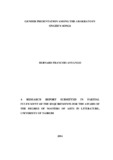| dc.description.abstract | The study, gender presentation among the abakhayo in ongidi‘s songs set out to
interrogate the cause and effect of the songs sung by the artist Vincent Ongidi among
the Bakhayos of Busia County. The impetus to study was borne out of the realization
that ordinary language as spoken could be harnessed by music to bring about harmony
among the genders. The study had as its objectives the analysis of the artist‘s
portrayal of men and women in his artistic works, the language and style that enabled
him to effectively do this and how this, significantly influence the way the two
genders perceive each other.
The study worked on the hypotheses that Ongidi portrays men and women as equal in
social status. His stylistic choices and language use was what made his songs appeal
equally to both genders and that the presentation, style and language use has had an
impact on how women and men view each other.
To help rationalize the area of engagement the study made use of the sociological
literary theory, ethnopoetic and the feminist literary theory. The selection of the
theories based on the understanding that literature has a social function and is not
created in vain. The study also handles the issue of women hence the feminist
consideration as a theoretical framework. Given that the texts under study are oral
productions ethnopoetics as a theory was indiscipensible.
The study was limited to the portrayal of women and men among the Abakhayo with
interest on the style and language that make this portrayal have the effect on how the
genders relate to each other.
In the study, I listened to Ongidi‘s selected songs, attended his live performances and
conducted interviews with him and his supporters using written quessionaires.
The study established that Ongidi‘s songs are not only received favourably across the
genders but even considered the standard texts of the Luhya community. The
language and style adopted makes it possible for both genders to like the music and
alter the way they perceive each other. | en_US |

